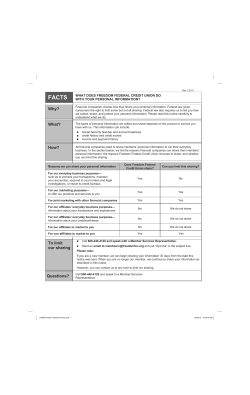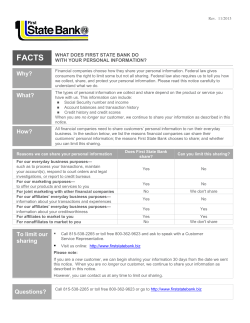
BOF3305_Selle-JavaFXPorting2014
Porting JavaFX Embedded Lisa Selle Principal Member of Technical Staff JavaFX Embedded September 29, 2014 Copyright © 2014, Oracle and/or its affiliates. All rights reserved. Safe Harbor Statement The following is intended to outline our general product direction. It is intended for information purposes only, and may not be incorporated into any contract. It is not a commitment to deliver any material, code, or functionality, and should not be relied upon in making purchasing decisions. The development, release, and timing of any features or functionality described for Oracle’s products remains at the sole discretion of Oracle. Copyright © 2014, Oracle and/or its affiliates. All rights reserved. 3 Program Agenda 1 JavaFX Embedded 8u6 reference implementation 2 JavaFX embedded porting overview 3 Porting JavaFX embedded to a new platform 4 Monocle – the new JavaFX embedded porting layer 5 Creating a new Monocle implementation Copyright © 2014, Oracle and/or its affiliates. All rights reserved. 4 Program Agenda 1 JavaFX Embedded 8u6 reference implementation 2 JavaFX embedded porting overview 3 Porting JavaFX embedded to a new platform 4 Monocle – the new JavaFX embedded porting layer 5 Creating a new Monocle implementation Copyright © 2014, Oracle and/or its affiliates. All rights reserved. 5 JavaFX Embedded 8u6 Reference Implementation What is provided • Full screen framebuffer – Provides for multiple stages/windows without an OS-level window manager • Supports both hardware-accelerated rendering and software fallback • Supports Linux input – Keyboards – Mouse – Touch and multi-touch devices Copyright © 2014, Oracle and/or its affiliates. All rights reserved. 6 JavaFX Embedded 8u6 Reference Implementation Current Platforms • Supported platforms: – Freescale i.MX6 Sabre Device Platform (Hard-float ABI) • Known to work: – Raspberry Pi model B (Hard-float ABI) – Beagleboard XM rev C (Soft-float) Copyright © 2014, Oracle and/or its affiliates. All rights reserved. 7 JavaFX Embedded 8u6 Reference Implementation Building JavaFX Embedded (OpenJFX) • Reference build using Linux desktop tools – Gradle 1.4 – GCC 4.7.2 – Platform SDK for headers/system libraries (for cross build) • OpenJFX wiki has documentation for arm hard float cross build – https://wiki.openjdk.java.net/display/OpenJFX/Main Copyright © 2014, Oracle and/or its affiliates. All rights reserved. 8 Program Agenda 1 JavaFX Embedded 8u6 reference implementation 2 JavaFX embedded porting overview 3 Porting JavaFX embedded to a new platform 4 Monocle – the new JavaFX embedded porting layer 5 Creating a new Monocle implementation Copyright © 2014, Oracle and/or its affiliates. All rights reserved. 9 JavaFX Embedded Porting Overview • Why is porting required? – EGL framebuffer initialization is not standardized across platforms – Framebuffer layer management is not standardized across platforms – Allows support for new input devices to be added Copyright © 2014, Oracle and/or its affiliates. All rights reserved. 10 JavaFX Embedded Porting Overview Target platform requirements • RAM – JavaVM + JavaFX requires 34MB ram minimum – More memory will be needed depending on the size and complexity of the application • ROM – JavaVM Compact1 profile with JavaFX Graphics requires 18MB minimum – More storage will be needed depending on the size and complexity of the application Copyright © 2014, Oracle and/or its affiliates. All rights reserved. 11 JavaFX Embedded Porting Overview Target platform requirements • VRAM – VRAM requirements can be high, particularly if large images are used – VRAM is also consumed by fonts and gradients – JavaFX has mechanisms to allow it try to work within VRAM limits; this can be specified on the command line – More information on OpenJFX wiki Copyright © 2014, Oracle and/or its affiliates. All rights reserved. 12 JavaFX Embedded Porting Overview Target platform requirements (continued) • Operating system for the target device (reference implementation assumes Linux; other operating systems could be supported) • Native drivers for any input devices you wish to support • Font support – Freetype/pango libraries – A port could add an alternative font engine which may have other native requirements • Java runtime environment (JRE) version 8 or better Copyright © 2014, Oracle and/or its affiliates. All rights reserved. 13 JavaFX Embedded Porting Overview Target platform requirements (continued) • Framebuffer management, either: – Direct framebuffer, full screen access • EGL drivers that support direct access to the framebuffer • OpenGL ES drivers for hardware accelerated graphics • Software fallback is available if hardware acceleration is not available – System-provided window management • GTX for X11 • EGL/GLX OpenGL/OpenGL ES drivers Copyright © 2014, Oracle and/or its affiliates. All rights reserved. 14 Program Agenda 1 JavaFX embedded 8u6 reference implementation 2 JavaFX embedded porting overview 3 Porting JavaFX embedded to a new platform 4 Monocle – the new JavaFX embedded porting layer 5 Creating a new Monocle implementation Copyright © 2014, Oracle and/or its affiliates. All rights reserved. 15 Porting JavaFX Embedded to a New Platform Operating System • Operating system setup can be a very challenging part of a new port – It can be difficult to find an integrated OS with all the necessary pieces; it’s often necessary to build it up piecemeal, beginning with an OS then adding vendor-specific drivers and libraries – Documentation on platform-specific features such as EGL initialization and framebuffer layer management (where available) can be difficult to come by • Non-linux operating systems will present additional challenges; plan for additional efforts on fonts, cursors, input, and build setup Copyright © 2014, Oracle and/or its affiliates. All rights reserved. 16 Porting JavaFX Embedded to a New Platform Build Setup • Obtain cross compiler and development tools • Read the build section on OpenJFX wiki • Using this as a guide, you will need to create a new build profile for your platform – Provides paths to compiler and build tools, specifies build/link flags – Toggles the build options Copyright © 2014, Oracle and/or its affiliates. All rights reserved. 17 Porting JavaFX Embedded to a New Platform Window Management • Current choices for window management: – Glass/GTK with X11 – Monocle • Provides management for multiple stages/window • Does not provide any mechanism for interaction with other native windows (assumes full-screen ownership) • Provides mechanism for platform-specific initialization of drawing surfaces, input device management, and cursor handling – Custom • Roll your own! If you need to interact with a native window manager other than X11 Copyright © 2014, Oracle and/or its affiliates. All rights reserved. 18 Program Agenda 1 JavaFX embedded 8u6 reference implementation 2 JavaFX embedded porting overview 3 Porting JavaFX embedded to a new platform 4 Monocle – the new JavaFX embedded porting layer 5 Creating a new Monocle implementation Copyright © 2014, Oracle and/or its affiliates. All rights reserved. 19 Monocle – the New JavaFX Embedded Porting Layer What is Monocle? • Glass implementation for systems that do not have an underlying window manager • Written almost entirely in java (previous porting layer, lens, relied heavily on native code) Copyright © 2014, Oracle and/or its affiliates. All rights reserved. 20 Monocle – the New JavaFX Embedded Porting Layer What are the goals of Monocle? • Functional and quality parity with lens on all platforms • Simplify the process of porting to a new platform • Minimize native code • Improve maintainability and debuggability of embedded ports • Pluggability of Linux input device handlers Copyright © 2014, Oracle and/or its affiliates. All rights reserved. 21 Monocle – the New JavaFX Embedded Porting Layer Generic components of Monocle • Glass integration classes (MonocleApplication, MonocleWindow, MonocleView) - interface with the rest of glass. These classes run on the application thread. • Window management classes (MonocleWindow, MonocleWindowManager) – manage window state of individual windows and z-order of the window stack. These classes run on the application thread. Copyright © 2014, Oracle and/or its affiliates. All rights reserved. 22 Monocle – the New JavaFX Embedded Porting Layer Generic components of Monocle (continued) • Input device management (InputDeviceXXX, InputDeviceRegistry) – InputDevices represent individual devices and deliver their associated events. The input device registry manages all input devices. The generic input device code runs on the application thread. • Input handling (MouseInput/State, TouchInput/State, KeyInput/State) – process various types of input. These classes run on the application thread. • Platform – abstract out the platform-specific functionality, such as initialization of the platform and screen, and management of the cursor (NativePlatform, NativeScreen, NativeCursor). Copyright © 2014, Oracle and/or its affiliates. All rights reserved. 23 Monocle – the New JavaFX Embedded Porting Layer Available monocle platforms • The following monocle platforms are available in the 8u6 release of JavaFX embedded (and also in OpenJFX): – Linux – generic Linux port, low-level input device nodes and a hardware cursor – OMAP – for the Beagleboard xM, EGL/framebuffer with Linux device input and a hardware cursor – MX6 – for the Freescale i.MX6, EGL/framebuffer with Linux device input and a hardware cursor – OMAPX11 – for the Beagleboard xM, EGL/X11 with Linux device input and a hardware cursor Copyright © 2014, Oracle and/or its affiliates. All rights reserved. 24 Monocle – the New JavaFX Embedded Porting Layer Available monocle platforms (continued) • The following monocle platforms are available in the 8u6 release of JavaFX embedded (and in OpenJFX): – DISPMAN – for the Raspberry Pi, with Linux device input and a hardware cursor – X11 – for generic Linux/X11 platforms, using X11 for input and cursor – Headless – provides neither input nor output. Used mainly for testing. • Other platforms which should fit but are not yet available: – Android Copyright © 2014, Oracle and/or its affiliates. All rights reserved. 25 Monocle – the New JavaFX Embedded Porting Layer Native Code in Monocle • While most of Monocle is written in Java, there are some classes which use JNI to access native C APIs: – C.java – provides access to C data structures. Requires loadLibrary* permission – LinuxSystem.java – provides access to selected Linux APIs. Requires loadLibrary* permission – X.java – provides access to X11 APIs – EGL.java – provides access to EGL APIs Copyright © 2014, Oracle and/or its affiliates. All rights reserved. 26 Program Agenda 1 JavaFX embedded 8u6 reference implementation 2 JavaFX embedded porting overview 3 Porting JavaFX embedded to a new platform 4 Monocle – the new JavaFX embedded porting layer 5 Creating a new Monocle implementation Copyright © 2014, Oracle and/or its affiliates. All rights reserved. 27 Monocle – the New JavaFX Embedded Porting Layer Creating a new Monocle implementation • To create a new Monocle implementation, you will need to provide platform-specific subclasses of: – NativeScreen – AcceleratedScreen (if you wish to support hardware-accelerated rendering) – NativeCursor (if you are using a pointing device and wish to support hardwareaccelerated rendering) – InputDeviceRegistry – NativePlatform – NativePlatformFactory Copyright © 2014, Oracle and/or its affiliates. All rights reserved. 28 Monocle – the New JavaFX Embedded Porting Layer Creating a new Monocle implementation - NativeScreen • Provides information about the screen it is using, and blits pixels to the screen in the software rendering path • Often this class is based on a Linux framebuffer but could be based on something else – Example: X11Screen – creates a single X window and renders into it Copyright © 2014, Oracle and/or its affiliates. All rights reserved. 29 Monocle – the New JavaFX Embedded Porting Layer Creating a new Monocle implementation - AcceleratedScreen • Provides a way to get an OpenGL ES context to the screen • Typically uses EGL API to create a drawing surface • EGL requires a NativeWindowType parameter whose meaning varies from platform to platform • The method used to obtain this parameter typically needs to be customized for each new port Copyright © 2014, Oracle and/or its affiliates. All rights reserved. 30 Monocle – the New JavaFX Embedded Porting Layer Creating a new Monocle implementation - NativeCursor • Not needed for software rendering platforms (a SoftwareCursor is supplied) • Method for getting a hardware cursor to the screen is very platform dependent; for example: – On TI OMAP3 devices, /dev/fb1 framebuffer overlay can be configured and used for the cursor – On Raspberry PI the dispman API can be used to create a separate graphics layer for the cursor – On Freescale .iMX6 a framebuffer overlay is used, but the API to access it is different than on the TI OMAP3 devices Copyright © 2014, Oracle and/or its affiliates. All rights reserved. 31 Monocle – the New JavaFX Embedded Porting Layer Creating a new Monocle implementation - InputDeviceRegistry • Handles discovery of input devices • Handles insertion of events from these devices into the JavaFX event queue • Default implementation uses the udev Linux system; other implementations are possible Copyright © 2014, Oracle and/or its affiliates. All rights reserved. 32 Monocle – the New JavaFX Embedded Porting Layer Creating a new Monocle implementation – NativePlatform, NativePlatformFactory • NativePlatformFactory – creates the NativePlatform implementation. The NativePlatformFactory whose match algorithm returns true for a particular platform is the one which will be selected. • The match algorithm can be based on various things – existence of specific system files, particular symbols present in a native library, etc. • NativePlatform – bundles together the NativeScreen, NativeCursor, and InputDeviceRegistry. • NativePlatform and the classes it contains are all singletons. Copyright © 2014, Oracle and/or its affiliates. All rights reserved. 33 Questions? Copyright © 2014, Oracle and/or its affiliates. All rights reserved. 34
© Copyright 2025










